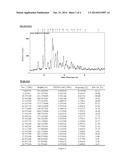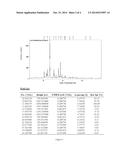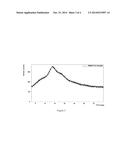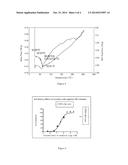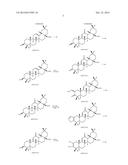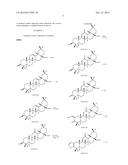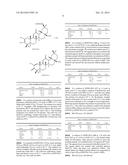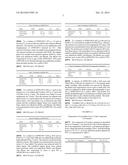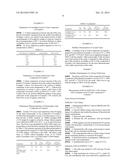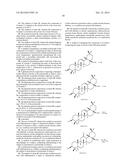Patent application title: POLYMORPHS OF CDDO ETHYL ESTER AND USES THEREOF
Inventors:
Zhijian Wang (Beijing, CN)
Xiaohong Zhang (Beijing, CN)
Xiaohong Zhang (Beijing, CN)
Lv Song (Beijing, CN)
Wendong Sun (Beijing, CN)
Kaiyang Liu (Beijing, CN)
Chunlei Han (Beijing, CN)
IPC8 Class: AC07C25547FI
USPC Class:
514519
Class name: Designated organic active ingredient containing (doai) ester doai cyano or isocyano bonded directly to carbon
Publication date: 2014-10-23
Patent application number: 20140315997
Abstract:
The present invention relates to polymorphic forms of the compound of
Formula I (i.e., ethyl 2-cyano-3,12-dioxoIeana-1,9(11)-dien-28-oate (CDDO
ethyl ester)) and methods of using them for treating a variety of disease
states such as cancer and condisitons associated with inflammation.
##STR00001##Claims:
1. A polymorph of the compound of Formula I. ##STR00009##
2. The polymorph of claim 1, wherein the polymorph is a glassy solid form and characterized by a Tg about 52.degree. C..+-.10.degree. C.
3. The polymorph of claim 1, wherein the polymorph is of crystalline Form I characterized by an X-ray powder diffraction pattern having characteristic peaks at diffraction angles 2.theta. of approximately 10.3.degree., 14.1.degree. and 14.6.degree..
4. The polymorph of claim 3, wherein the polymorph is of crystalline Form I characterized by the X-ray powder diffraction pattern having characteristic peaks, expressed in terms of the interplanar distance, at 8.6 Å, 6.3 Å and 6.1 Å.
5. The polymorph of claim 1, wherein the polymorph is of crystalline Form I characterized by the X-ray powder diffraction pattern having characteristic peaks at diffraction angles 2.theta. of approximately 10.3.degree., 14.1.degree., 14.6.degree., 15.8.degree., 16.6.degree. and 19.6.degree..
6. The polymorph of claim 5, wherein the polymorph is of crystalline Form I characterized by the X-ray powder diffraction pattern having characteristic peaks, expressed in terms of the interplanar distance, at 8.6 Å, 6.3 Å, 6.1 Å, 5.6 Å, 5.3 Å and 4.5 Å.
7. The polymorph of claim 1, wherein the polymorph is of crystalline Form I and characterized by an X-ray powder diffraction pattern having characteristic peaks at diffraction angles 2.theta. of approximately 10.3.degree., 14.1.degree., 14.6.degree., 15.7.degree., and 16.6.degree..
8. The polymorph of claim 7, wherein the polymorph has additional characteristic peaks at diffraction angles 2.theta. of approximately 9.3.degree. and 19.6.degree..
9. The polymorph of claim 1, wherein the polymorph is of crystalline Form 1 and characterized by a melting point of 174-177.degree. C.
10. The polymorph of claim 1, wherein the polymorph is a glassy solid form or of crystalline Form L and is characterized by a purity of ≧85%.
11. The polymorph of claim 10, characterized by a purity of ≧95%.
12. The polymorph of claim 11, characterized by a purity of ≧99%.
13. The polymorph of claim 1, wherein the polymorph is of crystalline Form II and characterized by an X-ray powder diffraction pattern having characteristic peaks at diffraction angles 2.theta. of approximately 10.4.degree., 12.1.degree. and 13.4.degree..
14. The polymorph of claim 13, wherein the X-ray powder diffraction pattern has additional characteristic peaks at diffraction angles 2.theta. of approximately 15.4.degree., 17.8.degree. and 18.8.degree..
15. The polymorph of claim 13, characterized by the X-ray powder diffraction pattern having characteristic peak, expressed in terms of the interpianar distance, at 8.5 Å, 7.3 Å and 6.6 Å.
16. The polymorph of claim 15, wherein the X-ray powder diffraction pattern has additional characteristic peaks, expressed in terms of the interpianar distance, at 5.7 Å, 5.0 Å and 4.7 Å.
17. The polymorph of claim 13, characterized by a melting point of 209-212.degree. C.
18. The polymorph of claim 13, characterized by a purity of ≧85%.
19. The polymorph of claim 18, characterized by a purity of ≧95%.
20. The polymorph of claim 19, characterized by a purity of ≧99%.
21. A method of preparing a crystalline polymorph of the compound of Formula I, comprising the steps of slurrying excess amount of the compound in a solvent of CH2Cl2, ethyl acetate, acetonitrile, ethanol, methanol, heptane, or a mixture thereof, for at least 24 hours, and recovering the resulted crystalline polymorph or a glassy solid form.
22. The method of claim 21, wherein the crystalline polymorph of the compound of Formula I is crystalline Form I or Form II.
23. The method of claim 21, wherein the compound of Formula I is slurried in the mixed solved at the room temperature or at 50.degree. C.
24. The method of claim 21, wherein the compound of Formula I is slurried in the solvent for at least 48 hours.
25. The method of claim 21, wherein the solvent is CH2Cl2, ethyl acetate, acetonitrile, ethanol, methanol, heptane, ethanol/heptane mixture, a ethyl acetate/heptane mixture, or a mixture thereof.
26. The method of claim 22, wherein the ethanes/heptane mixture has ethanol and heptane in die ratio of 1:10 weight by weight or volum by volum.
27. A method of preparing a crystalline polymorph of the compound of Formula L comprising the steps of dissolving the compound in a mixed solvent of ethanol and heptane at the room temperature, spontaneously precipitating the compound into a crystalline polymorph, and recovering the resulted crystalline polymorph.
28. A method of preparing a glassy solid form of the compound of Fomula I, comprising the steps of dissolving the compound in the solvent of dichloromethane at the room temperature or 50.degree. C., followed by evaporation of solvent to give a glassy solid form.
29. A pharmaceutical composition comprising a therapeutically effective amount of the polymorph of claim 1, and a pharmaceutically acceptable excipient, adjuvant or carrier.
30. The pharmaceutical composition of claim 29, further comprising an additional active ingredient.
31. The pharmaceutical composition of claim 29, wherein the polymorph is the crystalline Form I or II of the compound of Formula I.
32. The pharmaceutical composition of claim 29, wherein the composition is orally administered.
33. The pharmaceutical composition of claim 32, wherein the composition is used in tablet or capsule.
34. The pharmaceutical composition of claim 29, comprising 1-99 wt % of the polymorph.
35. The pharmaceutical composition of claim 34, comprising 1-70 wt % of the polymorph.
36. The pharmaceutical composition of claim 35, comprising 10-30 wt. % of the polymorph.
37. Use of a polymorph of claim 1 in the manufacturing of a medicament for inhibiting IFN-.gamma.-induced nitric oxide production in macrophages or for the treatment of a cancer or a condition associated with inflammation.
38. (canceled)
39. The use of claim 37, wherein the condition associated with inflammation is lupus or rheumatoid arthritis, Crohn's disease or ulcerative colitis, a cardiovascular disease, diabetes, or a condition associated with diabetes.
40. The use of claim 39, wherein the condition associated with diabetes is obesity, hypertension, atherosclerosis, coronary heart disease, stroke, peripheral vascular disease, hypertension, nephropathy, neuropathy, myonecrosis, retinopathy, metabolic syndrome (syndrome X), or a combination thereof.
41. A method of modulating nitric oxide production in macrophages in a subject, comprising administering to the subject in need thereof a polymorph of claim 1.
42. A method for treating a cancer or a condition associated with inflammation in a subject, comprising administering to the subject in need thereof a polymorph of claim 1.
43. The method of claim 42, wherein the condition associated with inflammation is lupus or rheumatoid arthritis, Crohn's disease or ulcerative colitis, a cardiovascular disease, diabetes, or a condition associated with diabetes.
44. The method of claim 43, wherein the condition associated with diabetes is obesity, hypertension, atherosclerosis, coronary heart disease, stroke, peripheral vascular disease, hypertension, nephropathy, neuropathy, myonecrosis, retinopathy, metabolic syndrome (syndrome X), or a combination thereof.
45. A method of preparing the compound of Formula I comprising the steps as shown in the following scheme. ##STR00010## ##STR00011## ##STR00012##
Description:
CROSS-REFERENCE TO RELATED APPLICATION
[0001] This application claims priority to PCT international application No. PCT/CN2012/082278, filed on 28 Sep. 2012, the contents of which are incorporated herein in their entirety.
FIELD OF THE INVENTION
[0002] The present invention relates to polymorphic forms of a triterpenoid compound, ethyl 2-cyano-3,12-dioxoIeana-1,9(11)-dien-28-oate (CDDO ethyl ester), and methods of using at least one of them in treating a variety of disease states, generally associated with inflammation.
BACKGROUND OF THE INVENTION
[0003] Triterpenoids are biosynthesized in plants by the cyclization of squalene. Although being candidates for medicinal use, these naturally occurring molecules display relatively weak biological activity. Accordingly, chemists have sought to synthesize analogues of enhanced potency (Honda et al, 1997 & 1998).
[0004] Several synthetic analogs are reported to suppress the denovo formation of cytokine-inducible nitric oxide synthase (iNOS) and cyclooxygenase-2 (COX-2) in macrophages that have been stimulated by IFN-γ or LPS (Suh et al, 1998; Honda et al, 2002). Among them, 2-cyano-3,12-dioxoleana-1,9(11)-dien-28-oate (CDDO), exhibits anti-inflammatory and anti-proliferative activity (Honda et al, 1998 & 2000). As noted, the study of triterpenoids as suppressors of iNOS activity, and specifically in the inhibition of NO production, has demonstrated the high potency of CDDO and CDDO methyl ester (IC50<1 nM level). See Honda et al. (2000). However, their therapeutic potential is believed to be not yet fully utilized, even less so for CDDO ethyl ester.
[0005] To realize the therapeutic potential of CDDO ethyl ester, depicted in Formula I, the present inventors investigated polymorphic forms of the compound. Consequently, the inventors discovered three polymorphic forms of CDDO ethyl ester, that have such advantageous properties (e.g., better pharmacokinetic profiles and greater systemic exposure) that make them ideal candidates for drug development.
SUMMARY OF THE INVENTION
[0006] In one aspect, the present invention provides polymorphs of the compound of Formula I, and/or hydrates or solvates thereof
##STR00002##
Among others, these polymorphs include at least two substantially pure crystalline forms and one substantially pure glassy solid form of the compound of Formula I. For convenience, these two crystalline forms are designated herein as Form I and Form II.
[0007] In some embodiments, the polymorph is a glassy solid form of the compound of Formula I and characterized having a Tg about 52° C.±10° C.
[0008] In some other embodiments, the polymorph is a glassy solid form of the compound of Formula I and characterized by an X-ray powder diffraction pattern having a characteristic peak at diffraction angles 2θ of approximately 14.3°.
[0009] In some other embodiments, a glassy solid form of the compound of Formula I is characterized by a purity of ≧85% (i.e., at least 85%). In yet still some embodiments, the purity is at least 95% or 99%.
[0010] In still some other embodiments, the polymorph is a crystalline polymorph form I of the compound of Formula I and characterized by an X-ray powder diffraction pattern having characteristic peaks at diffraction angles 2θ of approximately 10.3°, 14.1° and 14.6°.
[0011] In still some other embodiments, the polymorph is a crystalline polymorph form I of the compound of Formula I and characterized by the X-ray powder diffraction pattern having characteristic peaks at diffraction angles 2θ of approximately 10.3°, 14.1°, 14.6°, 15.8°, 16.6° and 19.6°.
[0012] In still some other embodiments, the polymorph is a crystalline polymorph form I of the compound of Formula I and characterized by the X-ray powder diffraction pattern having characteristic peaks, expressed in terms of the interplanar distance, at 8.6 Å, 6.3 Å and 6.1 Å.
[0013] In still some other embodiments, the polymorph is a crystalline polymorph form I of the compound of Formula I and characterized by the X-ray powder diffraction pattern having characteristic peaks, expressed in terms of the interplanar distance, at 8.6 Å, 6.3 Å, 6.1 Å, 5.6 Å, 5.3 Å and 4.5 Å.
[0014] Another subset of the embodiments of the polymorphs of this invention are of crystalline Form I.
[0015] In some of these embodiments, crystalline Form I of the compound of Formula I is characterized by an X-ray powder diffraction pattern having characteristic peaks at diffraction angles 2θ of approximately 10.3°, 14.1°, 14.6°, 15.7°, and 16.6°.
[0016] In some other embodiments, crystalline Form I of the compound of Formula I has additional characteristic peaks at diffraction angles 2θ of approximately 9.3° and 19.6°, in its X-ray powder diffraction pattern.
[0017] In still some other embodiments, crystalline Form I of the compound of Formula I is characterized by a melting point of 174-177° C.
[0018] In some other embodiments, crystalline Form I of the compound of Formula I is characterized by a purity of ≧85% (i.e., at least 85%). In yet still some embodiments, the purity is at least 95% or 99%.
[0019] Still another subset of the embodiments of the polymorphs of this invention are of crystalline Form II.
[0020] In some of these embodiments, crystalline Form II of the compound of Formula I is characterized by an X-ray powder diffraction pattern having characteristic peaks at diffraction angles 2θ of approximately 10.4°, 12.1° and 13.4°.
[0021] In some other embodiments, crystalline Form II of the compound of Formula I has additional characteristic peaks at diffraction angles 2θ of approximately 15.4°, 17.8° and 18.8°, in its X-ray powder diffraction pattern.
[0022] In some other embodiments, crystalline Form II of the compound of Formula I is characterized by the X-ray powder diffraction pattern having characteristic peak, expressed in terms of the interplanar distance, at 8.5 Å, 7.3 Å and 6.6 Å.
[0023] In some other embodiments, crystalline Form II of the compound of Formula I has additional characteristic peaks, expressed in terms of the interplanar distance, at 5.7 Å, 5.0 Å and 4.7 Å.
[0024] In some other embodiments, crystalline Form II of the compound of Formula I is characterized by a melting point of 209-212° C.
[0025] In some other embodiments, crystalline Form II of the compound of Formula I has a purity of not less than 85% (e.g., at least 95% or at least 99%).
[0026] In another aspect, the invention also relates to methods for making crystalline polymorphs of the compound of Formula I.
[0027] An embodiment of the method includes the steps of slurrying excess amount of the compound in a solvent of CH2Cl2, ethyl acetate, acetonitrile, ethanol, methanol, heptane, or a mixture thereof, for at least 24 hours, and recovering the resulted crystalline polymorph or a glassy solid form.
[0028] In some examples, the resultant crystalline forms can be either Form I or Form II.
[0029] In some other examples, the compound of Formula I is slurried in the mixed solvant at the room temperature or at 50° C.
[0030] In some other examples, the compound of Formula I is slurried in the solvent for at least 48 hours.
[0031] The solvent can be an ethyl acetate/heptane mixture, a ethanol/heptane mixture. For example, the ethyl acetate/heptane mixture can have ethyl acetate and heptane in the ratio of 1:10 (weight by weight or volum by volum).
[0032] To give a polymorph of this invention, crystallizing the compound of Formula I from a suitable solvent system comprising at least one solvent can be achieved by methods of spontaneous precipitation (evaporation), cooling, or adding anti-solvent (in which the compound of the present invention has relatively lower solubility), in order to achieve oversaturation in a solvent system. Crystallization also can be achieved by using or not using crystal seeds that is suitable for crystallizing the compound of the present invention.
[0033] In some other examples, the compound of Formula I of this invention is dissolved in the solvent heptane at the room temperature, followed by a spontaneous precipitation to obtain the desired crystalline Form I, with the melting point of 174-177° C.
[0034] In some other examples, a slurry suspension of excess amount of the compound of Formula I of this invention is stirred in the mixed solvent of ethyl acetat/heptane (1:10 weight by weight or volum by volum ) at the room temperature or 50° C for at least 48 hours, to obtain crystalline Form II, with the melting point of 209-212° C.
[0035] In some other examples, a slurry suspension of excess amount of the compound of Formula I of this invention is dissolved in the solvent of dichloromethane at the room temperature or 50° C., followed by evaporation of solvent to give a glassy solid form of the compound of Formula I with a Tg in a range of 52° C.±10° C.
[0036] The present invention further provides uses of the polymorphs of the compound of Formula I (including crystalline Forms I and II and the glassy solid form) for treating physical disorders or conditions, particularly those associated with inflammation, or for manufacturing medicament for treating physical disorders or conditions, e.g., those involving acute or chronic oxidative stress and inflammation, particularly those characterized in part by over expression of inducible nitric oxide synthase (iNOS) or inducible cyclooxygenase-(COX-2).
[0037] Accordingly, the invention also relates to pharmaceutical compositions or medicaments each comprising at least a therapeutically effective amount of crystalline Form I or Form II or the glassy solid form of the present invention, and a pharmaceutically acceptable excipient, adjuvant or carrier. Optionally, the compositions or medicament can further include at least one additional active ingredient.
[0038] The pharmaceutical compositions or medicaments of this invention can be in a form or formulation appropriate for the condition or disease to be treated (e.g., in a tablet or capsule), and can be administered in the manner known in the art, e.g., orally.
[0039] The pharmaceutical compositions or medicaments of this invention can include 1-99 wt % (e.g., 1-70 wt %, 10-30 wt %,) of a polymorph of the compound of Formula I (e.g., crystalline Form I, crystalline Form II, or glassy solid form).
[0040] All the polymorphs of this invention (including the crystalline forms and the glassy solid form) are substantially or approximately pure. As used herein, the term "substantially pure" or "approximately pure" refers to at least 85 wt % (e.g., at least 95 wt % or at least 99 wt %) of the compound of Formula I exists in a polymorph the present invention, particularly in crystalline Form I or Form II.
[0041] The main peaks described in the crystalline and the glassy solid form polymorphs above are reproducible and are within the error limit (the specified value ±0.2).
[0042] In the present invention, "the X-ray powder diffraction pattern shown as in FIG. 1" refers to the X-ray powder diffraction pattern that show major peaks as in FIG. 1, wherein major peaks refer to those with the relative intensity greater than 10%, preferably greater than 30%, relative to the highest peak (with its relative intensity designated to be 100%) in FIG. 1. Likewise, in the present invention, the X-ray powder diffraction pattern shown as in FIG. 2 refers to the X-ray powder diffraction pattern that show major peaks as in FIG. 2, wherein major peaks refer to those with the relative intensity greater than 10%, preferably greater than 30%, relative to the highest peak (with its relative intensity designated to be 100%) in FIG. 2, respectively.
[0043] Also within the scope of this invention are methods for preparing the compound of Formula I each of which includes steps shown in the following scheme:
##STR00003## ##STR00004## ##STR00005##
[0044] The present invention also provides the use of the compound of Formula I, or a polymorph or form selected from Crystalline Form I, Crystalline Form II, the glassy solid form, thereof, in manufacturing a medicament for inhibiting IFN-γ-induced NO production in macrophages, or for the treatment of cancer, or for the treatment of a disease, disorder, or condition with an inflammatory component, such as lupus or rheumatoid arthritis, Crohn's disease or ulcerative colitis, a cardiovascular disease, diabetes, one or more complications associated with diabetes wherein the complications are selected from the group consisting of obesity, hypertension, atherosclerosis, coronary heart disease, stroke, peripheral vascular disease, hypertension, nephropathy, neuropathy, myonecrosis, retinopathy and metabolic syndrome (syndrome X), or a combination of two or more thereof.
[0045] As used herein, the term "therapeutically effective amount" refers to the amount of a compound that, when administered to a subject for treating a disease, or at least one of the clinical symptoms of a disease or disorder, is sufficient to affect such treatment for the disease, disorder, or symptom. The "therapeutically effective amount'" can vary with the compound, the disease, disorder, and/or symptoms of the disease or disorder, severity of the disease, disorder, and/or symptoms of the disease or disorder, the age of the subject to be treated, and/or the weight of the subject to be treated. An appropriate amount in any given instance can be apparent to those skilled in the art or can be determined by routine experiments. In the case of combination therapy (i.e., having at least another active ingredient in addition to a polymorph of this invention), the term "therapeutically effective amount" refers to the total amount of the combination objects for the effective treatment of a disease, a disorder or a condition.
[0046] The pharmaceutical composition comprising the compound of the present invention can be administrated via oral, inhalation, rectal, parenteral or topical administration to a subject who needs treatment. For oral administration, the pharmaceutical composition may be a regular solid formulation such as tablets, powder, granule, capsules and the like, a liquid formulation such as water or oil suspension or other liquid formulation such as syrup, solution, suspension or the like; for parenteral administration, the pharmaceutical composition may be solution, water solution, oil suspension concentrate, lyophilized powder or the like. Preferably, the formulation of the pharmaceutical composition is selected from tablet, coated tablet, capsule, suppository, nasal spray or injection, more preferably tablet or capsule. The pharmaceutical composition can be a single unit administration with an accurate dosage. In addition, the pharmaceutical composition may further comprise additional active ingredients.
[0047] All formulations of the pharmaceutical composition of the present invention can be produced by the conventional methods in the pharmaceutical field. For example, the active ingredient can be mixed with one or more excipients, then to make the desired formulation. The "pharmaceutically acceptable carrier" refers to conventional pharmaceutical carriers suitable for the desired pharmaceutical formulation, for example: a diluent, a vehicle such as water, various organic solvents, etc, a filler such as starch, sucrose, etc; a binder such as cellulose derivatives, alginates, gelatin and polyvinylpyrrolidone (PVP); a wetting agent such as glycerol; a disintegrating agent such as agar, calcium carbonate and sodium bicarbonate; an absorption enhancer such as quaternary ammonium compound; a surfactant such as hexadecanol; an absorption carrier such as Kaolin and soap clay; a lubricant such as talc, calcium stearate, magnesium stearate, polyethylene glycol, etc. In addition, the pharmaceutical composition further comprises other pharmaceutically acceptable excipients such as a decentralized agent, a stabilizer, a thickener, a complexing agent, a buffering agent, a permeation enhancer, a polymer, aromatics, a sweetener, and a dye. Preferably, the excipient is suitable for desired formulation and administration type.
[0048] As used herein, the term "solvate" refers to the chemical entity formed by the interaction of a solvent and a compound. Suitable solvates are pharmaceutically acceptable solvates, such as hydrates, including monohydrates and hemi-hydrates.
[0049] As used herein, the term "active ingredient" is used to indicate a chemical entity which has biological activity. In certain embodiments, an "active agent" is a compound having pharmaceutical utility. For example, an active agent may be an anti-cancer therapeutic.
[0050] The term "disease" or "disorder" or "condition" refers to any disease, discomfort, illness, symptoms or indications.
BRIEF DESCRIPTION OF THE FIGURES
[0051] FIG. 1 shows the X-ray powder diffraction pattern of Crystalline Form I of the compound of Formula I
[0052] FIG. 2 shows the X-ray powder diffraction pattern of Crystalline Form II of the compound of Formula I
[0053] FIG. 3 shows the X-ray powder diffraction pattern of the glassy solid form of the compound of Formula I.
[0054] FIG. 4 shows the Heat Flow (w/g) of a glassy solid form.
[0055] FIG. 5 shows the inhibitory effect of Crystalline Form II of the compound of Formula I (CDDO ethyl ester) against the nitric oxide production induced by IFN-g in mouse macrophages 17.
DETAILED DESCRIPTION OF THE INVENTION
[0056] The X-ray powder diffraction (XRPD) patterns shown as in FIGS. 1, 2, 3 were generated on a PANalytical X-ray Diffraction System with Empyrean console. The diffraction peak positions were calibrated by single crystal silicon which has a 2θ value of 28.443 degree. The K-Alpha radiation of an Empyrean Cu LEF X-ray tube was used as the light source of the X-ray.
[0057] The present invention is further exemplified, but not limited, by the following examples that illustrate the invention. In the examples of the present invention, the techniques or methods, unless expressly stated otherwise, are conventional techniques or methods known in the art.
EXAMPLE 1
Synthesis of the Compound of Formula I
##STR00006## ##STR00007## ##STR00008##
TABLE-US-00001
[0058] Step 1 Synthesis of APSN13B-1 Name M.W. Amount mol equiv Oleanolic acid 456 1000 g 2.2 mol 1 EtI 156 376 g 2.4 mol 1.1 K2CO3 138 604 g 4.4 mol 2 DMF / 12 L / /
[0059] To a solution of oleanolic acid (1000 g, 2.2 mol) and potassium carbonate (604 g, 4.4 mol) in DMF (12 L) was added ethyl iodide (376 g, 2.4 mol). The mixture was stirred at 45° C. overnight. After disappearance of oleanolic acid detected by HPLC, the mixture was cooled to the room temperature and was poured into water (120 L). The resulting suspension was stirred for 30 minutes. The solid was collected by centrifuge, washed with water (1 L) and dried in vacuo at 50° C. to afford 976 g APSN13B-1 for late ruse. The yield was 92%.
TABLE-US-00002 Step 2. Synthesis of APSN13B-2 Name M.W. Amount mol equiv APSN13B-1 484 975 g 2 mol 1 Ac2O 102 612 g 6 mol 3 Pyridine 79 474 g 6 mol 3 THF / 6 L / / DMAP 122 24.4 g 0.2 mol.sup. 0.1
[0060] To a mixture of APSN13B-1 (975 g, 2 mol), pyridine (474 g), DMAP (24.4 g, 0.2 mol) in THF (6 L) was added acetic anhydride (612 g, 6 mol) at 45° C. The solution was stirred overnight. After the reaction finished, the solution was poured into water (60 L). The solid was collected by centrifuge and dried in vacuo at 45° C. to give 847 g APSN13B-2 for later use. The yield was 80%.
TABLE-US-00003 Step 3. Synthesis of APSN13B-3 Name M.W. Amount mol equiv APSN13B-2 526 846 g 1.6 mol 1 H2O2 34 136 g .sup. 4 mol 2.5 HCOOH 46 1 L / / DCM / 5 L / /
[0061] To a solution of APSN13B-2 (846 g, 1.6 mol), formic acid (1 L) in DCM (5 L) was added hydrogen peroxide (30%, water solution) (453 g, 4 mol) slowly at room temperature and stirred overnight. The solution was added water (2 L) and extracted with DCM. The organic phase was washed with saturated aqueous NaHCO3 until the water phase was neutral and then washed with brine and dried over anhydrous NaSO4. The organic phase was filtered and the filtrate was evaporated in vacuo to give 871 g APSN13B-3 for a yield of 100%. This material was used for the next reaction without further purification.
TABLE-US-00004 Step 4. Synthesis of APSN13B-4 Name M.W. Amount Mol equiv APSN13B-3 542 871 g 1.6 mol 1 HBr 81 30 ml / / Br2 160 768 g 4.8 mol 3 HAc / 7 L / /
[0062] To a solution of APSN13B-3 (871 g, 1.6 mol) in acetic acid (5 L) was added a solution of hydrobromic acid (30 ml) in acetic acid (40%) at 45° C. and then was added slowly a solution of bromine (256 g) in acetic acid (700 ml). The mixture was stirred at 45° C. for 30 minutes. Another solution of bromine (512 g) in acetic acid (1.3 L) was added slowly and continued to stir overnight at room temperature. When the reaction finished, the mixture was poured into cold water (35 L). The solid was collected, washed with saturated sodium sulfite solution and dried in vacuo to give the yellow solid 841 g APSN13B-4, for a yield of 97%.
[0063] MS-ESI (m/z): 541 [M+H].sup.+
TABLE-US-00005 Step 5. Synthesis of APSN13B-5 Name M.W. Amount mol equiv APSN13B-4 540 840 g 1.56 mol 1 KOH 56 263 g 4.7 mol 3 EtOH / 4.5 L / /
[0064] A solution of APSN13B-4 (840 g, 1.56 mol) and KOH (263 g, 4.7 mol) in EtOH (4.5 L) was heated under reflux for 30 minutes. After removal of EtOH in vacuo, the resultant mixture was acidified with a 6 N aqueous HCl solution. The aqueous layer was extracted with ethyl acetate (3 L). The organic phase was washed with saturated aqueous NaHCO3, brine and dried over anhydrous NaSO4. The organic phase was filtered and the filtrate was evaporated in vacuo to give 928 g APSN13B-5 for a yield of 100%.
[0065] MS-ESI (m/z): 499 [M+H].sup.+.
TABLE-US-00006 Step 6. Synthesis of APSN13B-6 Name M.W. Amount mol equiv APSN13B-5 498 927 g 1.8 mol 1 Jones reagent 100 400 ml 1.8 mol 1 acetone / 5 L / /
[0066] To a solution of APSN13B-5 (927 g, 1.8 mol) in acetone (5 L) in an ice bath was added Jones reagent (400 ml) dropwise. The mixture was stirred at room temperature until disappearance of APSN13B-5 detected by TLC. After removal of acetone, water was added to the resultant mixture. The aqueous mixture was extracted with DCM. The organic phase was washed with saturated aqueous NaHCO3, brine, dried over anhydrous NaSO4 and filtered. The filtrate was evaporated in vacuo to give crude APSN13B-6. 498 g pure APSN13B-6 was obtained through recrystallization in petroleum and ethyl acetate, for a yield of 54%.
[0067] MS-ESI (m/z): 497 [M+H].sup.+
TABLE-US-00007 Step 7. Synthesis of APSN13B-7 Name M.W. Amount mol equiv APSN13B-6 496 496 g 1 mol 1 CH3ONa 54 216 g 4 mol 4 HCOOEt 74 185 g 2.5 mol.sup. 2.5 Dry toluene / 2 L / /
[0068] To a solution of APSN13B-6 (496 g, 1 mol) in dry toluene (2 L) was added ethyl formate (185 g, 2.5 mol) and CH3ONa (216 g, 4 mol). The mixture was stirred at room temperature for 2 hours. Then the mixture was diluted with ethyl acetate (1 L) and washed with 5% aqueous HCl solution (three times). The water phase was re-extracted with ethyl acetate and the combined organic layers was washed with brine, dried over anhydrous NaSO4 and filtered. The filtrate was evaporated in vacuo to give 497 g APSN13B-7 for a yield of 95%.
[0069] MS-ESI (m/z): 525 [M+H].sup.+
TABLE-US-00008 Step 8. Synthesis of APSN13B-8 Name M.W. Amount mol equiv APSN13B-7 524 496 g 0.94 mol 1 NH2OH HCl 69 98 g 1.4 mol 1.5 EtOH / 2.5 L / / water / 200 ml / /
[0070] To a solution of APSN13B-7 (496 g, 0.94 mol) in EtOH (2.5 L) and water (200 ml) was added hydroxylamine hydrochloride (98 g, 1.4 mol). The mixture was heated under reflux for 2 hours. The mixture was concentrated in vacuo and water (2 L) was added. The mixture was extracted with EA (three times). The combined organic layers were washed water and brine, dried over anhydrous NaSO4 and filtered. The filtrate was evaporated in vacuo to give 453 g APSN13B-8 for a yield of 92%.
[0071] MS-ESI (m/z): 522 [M+H].sup.+
TABLE-US-00009 Step 9. Synthesis of APSN13B-9 Name M.W. Amount mol equiv APSN13B-8 521 452 g 0.86 mol 1 CH3ONa 54 56 g 1.04 mol 1.2 EtOH / 1.5 L / /
[0072] To a solution of APSN13B-8 (452 g, 0.86 mol) in EtOH (1.5 L) in ice bath was added CH3ONa (56 g, 1.04 mol). The mixture was stirred at room temperature for 1 hour. The mixture was concentrated in vacuo and ethyl acetate (2 L) was added. The mixture was washed with 5% aqueous HCl solution (three times). The water phase was re-extracted with EA and the combined organic layers was washed with brine, dried over anhydrous NaSO4 and filtered. The filtrate was evaporated in vacuo to give 429 g APSN13B-9 for a yield of 95%.
[0073] MS-ESI (m/z): 522 [M+H].sup.+
TABLE-US-00010 Step 10. Synthesis of APSN13B-10 (Compound of Formula I) Name M.W. Amount mol equiv APSN13B-9 521 428 g 0.82 mol 1 DDQ 227 205 g 0.90 mol 1.1 tolunene / 2.5 L / /
[0074] A mixture of APSN13B-9 (428 g, 0.82 mol) and DDQ (205 g, 0.90 mol) in toluene (2.5 L) was heated under reflux overnight. After insoluble was removed by filtration, the filtrate was evaporated in vacuo to give a crude solid. The solid was subjected to flash column chromatography to give 341 g APSN13B-10 for a yield is 80%. The product was further purified through re-crystallization in ethyl acetate and petroleum ether to give chemical purity product. The maximum impurity of final product is less than 0.1%.
[0075] MS-ESI (m/z): 520 [M+H].sup.+
[0076] 1H-NMR (CDCl3): δ8.04 (1H, S), 5.96 (1H, S), 4.17 (2H, t, J=6.9 Hz), 3.05 (1H, d, J=13.5 Hz), 2.95 (1H, d, J=4.5 Hz), 2.04˜0.07 (21H, m).
EXAMPLE 2
Preparation of Crystalline Form I of the Compound of Formula I
[0077] The compound of Formula I prepared as described above in Example 1 was dissolved in the solvent heptane at the room temperature, followed by a spontaneous precipitation to obtain the desired crystalline Form I, with the melting point of 174-177° C. Its X-ray diffraction pattern depicted in FIG. 1 is summarized in Table 1.
TABLE-US-00011 TABLE 1 2θ (2 theta) ± 0.2 (degrees) d-spacing [Å] Rel. Int. [%] 10.3 8.6 100 14.1 6.3 83.2 14.6 6.1 63.8 15.8 5.6 44.6 16.6 5.3 49.7 19.6 4.5 35.8
EXAMPLE 3
Preparation of Crystalline Form II of the Compound of Formula I
[0078] 1. A slurry suspension of excess amount of the compound of Formula I prepared from the method described in Example 1 above, was stirred in the mixed solvent of ethyl acetat/heptane (1:10 weight by weight or volum by volum) at the room temperature or 50° C. for at least 48 hours, to obtain crystalline Form II, with the melting point of 209-212° C.
[0079] Its X-ray diffraction pattern depicted in FIG 2 is summarized in Table 2.
TABLE-US-00012 TABLE 2 2θ (2 theta) ± 0.2 (degrees) d-spacing [Å] Rel. Int. [%] 10.4 8.5 16.1 12.1 7.3 25.7 13.4 6.6 100 15.4 5.7 30.9 17.84 5.0 25.5 18.8 4.7 42.4
EXAMPLE 4
Preparation of a Glassy Solid Form of the Compound of Formula I
[0080] A slurry suspension of excess amount of the compound of Formula I prepared from the method described in Example 1 above, was dissolved in the solvent of dichloromethane at the room temperature or 50° C., followed by evaporation of solvent to give a glassy solid form of the compound of Formula I with a Tg about 52° C.±10° C. FIG. 3 shows the X-ray powder diffraction pattern of the glassy solid form of the compound of Formula I. FIG. 4 shows the Heat Flow (w/g) of a glassy solid form.
EXAMPLE 5
Preliminary Pharmacokinetics of Polymorphs of the Compound of Formula I
[0081] Female CD-I mice were injected ip with 10 mg/kg of the three polymorphs of the compound of Formula I (CDDO ethyl) and methyl 2-cyano-3,12-dioxoIeana-1,9(11)-dien-28-oate (CDDO methyl) in DMSO-cremphor-PBS (1:1:8 weight by weight or volum by volum). Blood samples were collected at 0.083, 0.25, 0.5, 1, 2, 4, 8, and 24 hr post-dose. The levels were quantified by HPLC/MS using compound add to control blood for standard. PK results are shown at Table 3. The systemic exposure of the three polymorphs of the compound of Formula I of CDDO ethyl is higher than that of CDD) methyl. Following is the order: The glassy solid form of CDDO ethyl>Crystalline Form II of CDDO ethyl>Crystalline Form I of CDDO ethyl>CDDO Methyl
TABLE-US-00013 TABLE 3 t1/2 tmax Cmax AUClast AUCInf Compound (hr) (hr) (ng/mL) (hr*ng/mL) (hr*ng/mL) CDDO Methyl 6.6 0.8 363 1805 1966 Ester The glassy solid 16.1 0.8 513 4721 7526 form of CDDO ethyl Crystalline Form I 8.3 0.8 466 3221 3456 of CDDO ethyl Crystalline Form II 7.3 0.8 482 3443 3840 of CDDO ethyl
EXAMPLE 6
Stability Determination of Crystal Forms
[0082] Crystalline Form II of the compound of Formula I, prepared as described in Example 3, was test at 25° C./60% R.H. and 40° C./75% R.H. There was no significant change of XRD of all the samples. Other polymorphs of this invention were used similar in the study. Compared to other polymorphs of this invention, crystalline Form II of the compound of Formula I was demonstrated to be the most thermodynamically stable crystal form in this study.
Example 7
Stability Determination of a Glassy Solid Form
[0083] The glassy solid Form of the compound of Formula I, prepared as described in Example 4, was test at 25° C./60% R.H. and 40° C./75% R.H for one week. There was no significant change of XRD of all the samples.
EXAMPLE 8
Measurement of NO in RAW 264.7 Cells Treated with Crystalline Form II of the Compound of Formula I
Assay Protocol Procedures
RAW264.7 Cell Culture
[0084] 1 Maintained RAW264.7 cells in DMEM with 10% FBS at 37° C., 5% CO2.
[0085] 2. Viewed cultures using a microscope to assess the degree of confluency and confirm the absence of bacterial and fungal contaminants.
[0086] 3. Removed spent medium.
[0087] 4. Washed the cell monolayer with pre-warmed D-PBS.
[0088] 5. With a pipette, moved 3 ml trypsin/EDTA onto the washed cell monolayer, rotated flask to cover the monolayer with trypsin.
[0089] 6. Examined the cells using a microscope to ensure that all the cells are detached and floating.
[0090] 7. Re-suspended the cells in a small volume of fresh serum-containing medium to inactivate the trypsin.
[0091] 8. Harvested cells by centrifugation, 1000 rpm for 5 minutes at the room temperature.
[0092] 9. Incubated the cells at 37° C. under 5% CO2.
Induction of NO in RAW264.7 Cells
[0093] 1. The cells were seeded at 1×105/well onto 96-well cell culture plate.
[0094] 2. After incubation for 2 hours at 37° C. under 5% CO2, the nonadherent cells were removed by aspiration and freshly prepared complete medium with 10 ng/ml IFN-γ and dilluted compounds was added.
[0095] 3. Incubated the cells at 37° C. under 5% CO2 for another 48 hours.
Measurement of NO in RAW Cells
[0096] 1. Centrifuged at 1000 rpm for 5 minutes to collect supernatant medium.
[0097] 2. Prepared 1 ml of a 100 μM nitrite solution by diluting the provided 0.1 M Nitrite Standard 1:1,000 in the matrix or buffer used for the experimental samples.
[0098] 3. Prepared Nitrite Standard 100, 50, 25, 12.5, 6.25, 3.13, 1.56 and 0 μM, 50 μl/well.
[0099] 4. Allowed the Sulfanilamide Solution and NED Solution to equilibrate to room temperature (15-30 minutes).
[0100] 5. Added 50 μl of each experimental sample to wells in duplicate.
[0101] 6. Used a multichannel pipettor to dispense 50 μl of the Sulfanilamide Solution to all experimental samples and wells containing the dilution series for the Nitrite Standard.
[0102] 7. Incubated 5-10 minutes at room temperature, protected from light.
[0103] 8. Used a multichannel pipettor to dispense 50 μl of the NED Solution to all wells.
[0104] 9. Incubated at the room temperature for 5-10 minutes, protected from light. A purple/magenta color began to form immediately.
[0105] 10. Measured absorbance within 30 minutes in a plate reader with a filter between 520 nm and 550 nm.
[0106] The inhibitory activities [as measured by the IC50 (nM) value] of Crystalline Form II of the compound of Formula I (CDDO ethyl ester) on NO production induced by IFN-g in mouse macrophages 17 are shown in FIG. 5. The IC50 of the Crystalline Form II of the compound of Formula I (CDDO ethyl ester) was 34 nM. The IC50 of the glassy solid form of the compound of Formula I (CDDO ethyl ester) was 32 nM.
User Contributions:
Comment about this patent or add new information about this topic:
| People who visited this patent also read: | |
| Patent application number | Title |
|---|---|
| 20210054330 | CELL CULTURE DEVICE, CELL CULTURE METHOD, AND RECORDING MEDIUM |
| 20210054329 | SWITCHING VALVE AND SUCTION-DISCHARGE DEVICE INCLUDING THE SAME |
| 20210054328 | Cell Expansion Vessel Systems and Methods |
| 20210054327 | Single Use Container Including a Collapsible Baffle Having Channels |
| 20210054326 | REACTOR FOR CELL GROWTH |


